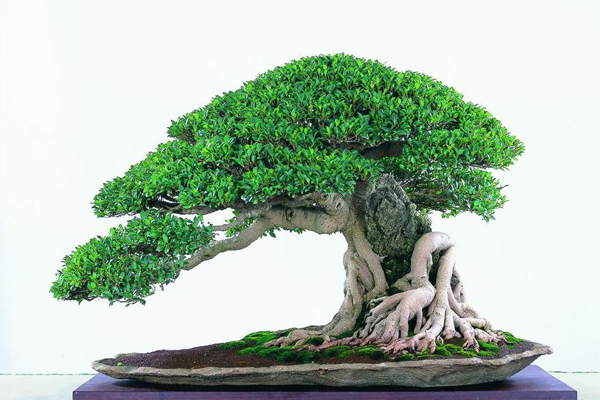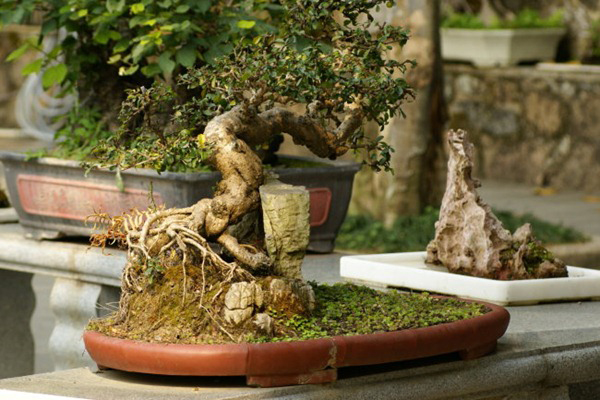How to make hydroponic banyan bonsai?
Banyan trees are plants that like moisture. In nature, banyan trees mostly grow on the banks of ponds and rivers, with roots on one side growing on the shore and roots immersed in water on the other. Many bonsai artists make excellent hydroponic bonsai according to this characteristic. There are two forms of culture of banyan potted plants: stone-attached water culture and flat-root water culture.
(1)Stone attached to water. Choose a stone with good water absorption (generally sand stone, sea mother stone, reed stone), and the shape of the stone should be elegant, and then plant the banyan tree on the stone. The roots of the banyan tree cling to the stone, and the roots grow along stone holes, stone ditches and processed stone crevices. Through one or two years of deep pot or set pot planting, so that the roots and stones closely associated. In April and May of the second and third years, the basin was turned over to remove soil and moved into the water basin for conservation and viewing. The basin is shallow, so pay attention to adding water frequently and applying granular fertilizer. When the basin is placed, the attached stone banyan tree should be placed on the left or right side of the tree, so that the big floating branches face the water, just like the stumps born on the stream stone.
(2)Flat roots and water. Select a short tree, has been shaped banyan bonsai, roots developed robust, roots arranged more beautiful for the best. To soil exposed roots, root scissors, tidied up, spread into claw shape, planted in square shallow pot culture. After one or two years of growth, many fine roots and fibrous roots grow neatly from the root cutting parts, and the neat root base can support the crown stably, and then remove the soil in April and May of the second and third years, and put it into the basin for conservation and viewing.
Water culture potted plants are shallow, so pay attention to adding water in time and changing water frequently. The growth period of fig trees is from April to October, during which about 30 grams of nitrogen, phosphorus and potassium compound fertilizer is put into each month, and several times of external fertilization can also be carried out, that is, potassium dihydrogen phosphate liquid fertilizer with the concentration of (5~10) times 10 to the fifth power is sprayed to the leaves. Due to the lack of soil and less nutrients, when the tree is cultivated for 3 to 5 years, if the tree body is found to grow poorly, it should be re-planted and rejuvenated. Later, depending on the growth of the tree body, it should be viewed in the water basin again. Ficus potted plants in hydroponic culture have poor stability. When pruning, the crown should be cut short to improve stability.
How to make a banyan potted plant?
How to make a banyan potted plant?
Banyan trees are plants that like moisture. In nature, banyan trees mostly grow on the banks of ponds and rivers, with roots growing on one side and submerged in water on the other. Many bonsai artists make excellent hydroponic bonsai according to this characteristic. There are two forms of culture of banyan potted plants: stone-attached water culture and flat-root water culture.
(1) Stone attached to water. Choose a stone with good water absorption (generally sand stone, sea mother stone, reed stone), and the shape of the stone should be elegant, and then plant the banyan tree on the stone. The roots of the banyan tree cling to the stone, and the roots grow along stone holes, stone ditches and processed stone crevices. Through one or two years of deep pot or set pot planting, so that the roots and stones closely associated. In April and May of the second three years, the basin was turned over to soil, and the basin was moved to a shallow water basin for maintenance. Attention should be paid to adding water frequently and applying granular fertilizer. On the basin when the attached stone banyan tree according to the tree to the left or right swing into, so that the big floating branches near the water, like a stump born on the stream stone.
(2) Flat roots and water. Select a short tree, has been shaped banyan bonsai, roots developed robust, roots arranged more beautiful for the best. To pay the root, the root cut flat, tidy up, spread into claw shape, planted in square shallow pot culture. After one or two years of growth, many fine roots and fibrous roots grow neatly from the cut parts, and the flat base can support the crown steadily, and then remove the soil in April and May of the second and third years, and put it into the basin for conservation and viewing.
Water culture potted plants are shallow, so pay attention to adding water in time and changing water frequently. The growth period of fig trees is from April to October, during which about 30g of nitrogen, phosphorus and potassium compound fertilizer can be added every month, and additional fertilizer can also be applied to the roots several times, that is, potassium dihydrogen phosphate liquid fertilizer with concentration of (5 ~]0)X10-5 can be sprayed to the leaves. Due to the lack of soil and less nutrients, when the tree is cultivated for 3 ~ 5 years, if the tree body is found to grow poorly, it should be re-planted and rejuvenated. Later, depending on the growth of the tree body, it should be viewed in the water basin again. Ficus potted plants in hydroponic culture have poor stability. When pruning, the crown should be cut short to improve stability.
Ficus: large trees, up to 15-25 meters high, DBH up to 50 cm, crown wide exhibition; old trees often rust brown aerial roots. Bark dark gray. Leaves thin leathery, narrowly elliptic, surface dark green, glossy, entire. Figs axillary in pairs or in axils of deciduous branches, yellow or reddish when mature, oblate globose, basal bracts 3, broadly ovate, persistent; male flowers, female flowers, gall flowers borne together in a fig, with a few short setae between flowers; tepals 3, broadly ovate, styles sublateral, stigmas short, clavate. Achenes ovoid. Flowers bloom from May to June.

Xinhua News Agency, Suzhou, August 17, 2006. A young woman displays a potted plant of ginseng and banyan trees in hydroponic culture on August 16. Recently, a ginseng-shaped banyan bonsai appeared in a hydroponic flower shop on Pishi Street in Suzhou City and was favored by some customers. This kind of potted plant is made of banyan tree, carefully trimmed by horticultural experts, and its shape is unique and vivid.
- Prev

How to replenish the roots of banyan bonsai?
The beauty of the banyan bonsai lies in the roots, stems, branches and leaves. If the shape of the stem and branches is very complete, but the root appears thin and powerless, the part of the root is defective, the number of the root is less, the root direction is offset, and the root size is uneven, it will affect the beauty of the whole. At this time, the root filling method can be used to make the root more perfect.
- Next

How to make banyan bonsai with stone?
The banyan tree has developed roots, soft roots and long roots, so it is a good material for making stone-attached bonsai. In the production of stone bonsai, choose mature, good artistic shape, long enough roots of the banyan stump, in order to create a reasonable sense of movement, but also make the stem have a sense of strength. Many gaps in choice and good posture
Related
- Fuxing push coffee new agricultural production and marketing class: lack of small-scale processing plants
- Jujube rice field leisure farm deep ploughing Yilan for five years to create a space for organic food and play
- Nongyu Farm-A trial of organic papaya for brave women with advanced technology
- Four points for attention in the prevention and control of diseases and insect pests of edible fungi
- How to add nutrient solution to Edible Fungi
- Is there any good way to control edible fungus mites?
- Open Inoculation Technology of Edible Fungi
- Is there any clever way to use fertilizer for edible fungus in winter?
- What agents are used to kill the pathogens of edible fungi in the mushroom shed?
- Rapid drying of Edible Fungi

